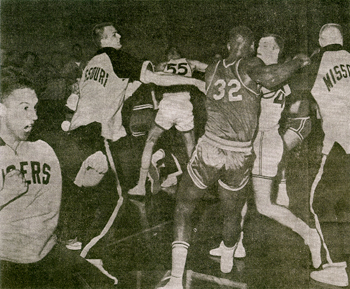Posted by cwilliams on February 1st, 2012
Each collegiate rivalry is encompassed by a rich history. Many date back over 100 years, and each rivalry has its unique moments, stories and anecdotes. However, no rivalry coincides with American history as much as the Missouri-Kansas rivalry, known simply around those parts as the Border War. The cities of Lawrence, Kansas, and Columbia, Missouri, have despised each other for as long as anyone can remember, but not in a way similar to the dislike between Columbus, Ohio, and Ann Arbor, Michigan. Kansans and Missourians loathed each other due to state political and social views, not because of football scores. The Border War is so rich with history that I thought it would be best to briefly touch on many of these spectacular moments, instead of focusing on just one.

Hide Ya Kids, Hide Ya Wife, the Border War is Coming this Weekend. (Mizzou Magazine)
- The initiation of the rivalry began around the 1850s, when Kansas and Missouri began burning down each other’s border cities during the Civil War. That’s right. Kansas residents would cross the border and burn down a Missouri city before heading home for supper, and vice versa. The tension reached it’s pinnacle when William Quantrill and his guerrilla forces rode into Lawrence and burned down parts of that city, ultimately murdering 200 people. Ironically, Quantrill was part of a group who attempted to burn down Columbia as well, because it was a Union stronghold during the Civil War. After the war, the athletic matches between Kansas and Missouri served as relief funds for the state’s recovery from the Civil War.
- Former Missouri hoops coach Norm Stewart refused to let his team’s busses stop in Kansas for fuel or allow his players to eat in Kansas. He didn’t want to put a single Missouri penny into the Kansas economy. On the Red and Blue side, former Jayhawk football coach Don Fambrough once refused to see a doctor in Kansas City, Missouri, stating “I’ll die first!”
- The first time Kansas and Missouri met on the football field was Halloween 1891. They hit the hardwood for the first time together in 1906, a 34-31 Missouri triumph.
| big 12, microsites
| Tagged: border war, kansas, missouri, Naismith, norm stewart, zaire taylor
Share this story











































